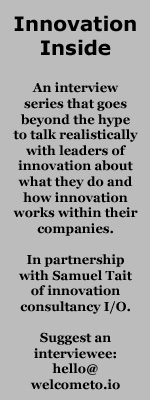The innovation mindset with Arno Lenior, former innovation leader at Lion Nathan
Share

As the former leader of group innovation at Lion Nathan, Arno Lenior is full of insights about how to go about bringing innovative processes into a company. In this interview with Samuel Tait, he discusses his top three must-visit events for innovation leaders; the value of innovation models such as Doblin’s 10 types of innovation and the Stage-Gate idea-to-launch model; the importance of working with cross-functional teams and more, providing examples from his time at Lion Nathan and more recently, as CMO at Samsung.
 Samuel Tait: Can you provide an example where innovation has driven business growth and delivered positive impact?
Samuel Tait: Can you provide an example where innovation has driven business growth and delivered positive impact?
Arno Lenior: When I was at Lion Nathan in New Zealand we had a major problem with the beer category. At that time it was flat lining, even in marginal decrease in terms of growth. In looking at the problem, we started with the product because I believed that the product was in need of innovation. We had to bring a fresh approach and to look at how we reinvigorate the category.
There is one that I’m proud of – that was ar ound brand innovation. That was around the Speight’s brand, which was the largest mainstream beer brand at the time. It was losing favor with 18-to-24-year-old drinkers because they were moving on to different categories.
ound brand innovation. That was around the Speight’s brand, which was the largest mainstream beer brand at the time. It was losing favor with 18-to-24-year-old drinkers because they were moving on to different categories.
Our focus was, ‘how do we innovate for that core audience with the Speight’s brand at the center?’ It was a brand innovation story. We did a whole bunch of campaigns like ‘The Great Beer Delivery’ from New Zealand to the UK. It was a very big piece of brand innovation because it delivered what we needed to reconnect with this group of consumers.
ST: Are there any models for innovation that you have used that have helped you succeed in delivering innovation?
AL: Absolutely. I’ve looked at a framework called the Blue Ocean Strategy. I thought that elements of the book were probably a bit of old strategy repackaged, but within the book are some really, really easy to understand concepts; the red ocean and the blue ocean, and where are you going to get your future growth from?
The case studies are tremendous, like Formula One Motels. They do a great job of making the complex easy to understand. Enabling you to see how a strategy has been put into action. Cirque du Soleil was another good case study. It showcased how they came up with the product. Asking questions like; What do people like about circuses? What don’t they like about circuses? Maybe take live animals out of the experience because people think it’s cruel, but they love the trapeze. Okay, keep the trapeze. What do they like about the theatre and how much do they pay at that theatre? People might pay $140 a ticket. You give them a glass of champagne. You give them beautiful food. Give them a great experience. Then what happens if you were to match the two, take the best of both? Cirque du Soleil started out from a Blue Ocean way of thinking.
Other models I have used have been developed by Benoit Godin, as well as the Doblin model. I have done quite a bit of research around theories of innovation. Specifically around what does innovation mean? How do you lead an organization to think about innovation? It is a way of thinking about a problem or an issue, so that you can increase and deliver better value for the organization, and for the consumer in the case of a consumer product. You are creating more value, so more bottom line revenue or sales. Whatever it is you also must create more value for the consumer who is consuming the product. It’s a win-win scenario but it starts with a mindset.
What the Doblin model talked about was that there are a number of different types of innovation. That was everything from financial innovation to product innovation, for example how do you financially reengineer your organisation for better results? Our finance team at Lion were saying, “Yeah, absolutely, we do this stuff all the time”. Then you can go all the way through to brand innovation, product innovation, all in, 10 different types of innovation. I remember a company conference, where our top 100 leaders from across the business participated. It was all about innovation and it was exactly what I was talking about; innovation is a mindset and here are 10 different types of innovation. It enables you to think about innovation holistically. You can then start to put a brewer together with a marketer, with the finance guy, and go, “You have to solve this problem using different innovations”. All too often organisations believe innovation is a marketing thing.
ST: In your use of Doblin’s model you talked about disciplines working together – how critical to innovation is using cross-functional teams to solve actual problems for the business?
AL: Massively; and I think it’s particularly critical in large complex organisations. The larger the organization the more important I think it is because there are just so many different points of view. You can’t be a specialist across all of the different disciplines. Taking the Steinlager example I’ve mentioned [in this interview]. In the beginning part of it, it was making sure that we had a CFO who understood what we were trying to do.
We had our chief brewer onboard, who was saying, “Okay, I understand that it had the chemical thing, so let me think about how I can help bring a skill set to the table which will combat that”. We had a packaging specialist, which had a viewpoint to help, “Okay, well, we need to re-package the product”. Then of course, you had the marketing guy and we had the product/brand guy. Having everybody involved at the beginning part of the project does two things; one, it provides the expertise you need to solve the problem properly in a complex organization. And two, it actually provides buy-in for everybody.
And I’ve seen mistakes happen, through some of the consulting I’ve done over the years for different organisations. In one example I was brought in to do a role and it was a marketing lead piece of innovation, product innovation specifically. The organisation tried to leave it to the marketing team to solve it by themselves. It just didn’t work. All they were actually able to do was to change the packaging and that didn’t solve the broader problem. The root cause of the problem was created by a category decline. Changing colors and pictures on a piece of packaging was not going to cut it.
ST: What is the role of process within innovation?
AL: Many organizations use process tools such as Stage-Gate to manage the innovation process.
While you can argue that innovation is a process, and I would agree to that somewhat, my counter-counsel is that sometimes creativity and innovation will come from any place. If you are too formulaic, prescriptive, sometimes you can miss an important nugget and I think that’s a really important thing to be aware of. You can’t be too formal about it.
That’s where a Stage-Gate process can be very good process to follow, but within that you’ve got to be able to have flexibility. Particularly I think in the insights generation. Who you go to speak to or where to you get that insight. Consumers don’t always know what they don’t know. You look at different categories or industries for example. You can put processes around that, but sometimes a genius idea can come from a creative director sitting at an ad agency going, “We just need to be doing that”. Now, there is no process around that.
ST: What is the value of going outside your business to get external viewpoints?
AL: I think it does a couple of things. Within FMCG there are not that many categories that have not foreseen the same problems. Whether that is chocolate, beer or whether it is soft drink, there are very similar category dynamics going on. The brand needs growth; the category needs growth and the major supermarkets want more margin. All of these are things that are business pressures, in the FMCG space, are fairly similar.
Being able to then go, “Okay. Well… we’ve got a beer problem. Let’s go and have a look at chocolate or coffee categories as they have similar market dynamics to ours. Take a look at an Nespresso, who have done an amazing job in their particular category. For beer interestingly enough, we looked at that category because of the similarities in the dynamics I mentioned before. Coffee is drunk at home and they’ve developed this home coffee kit called Nespresso. For beer; there’s similarity with the Heineken keg. I believe the Tap King came out of that as a process. There is great value in looking at different organizations in different categories, but with similar problems – find out how do they deal with it.
Then you can just search and spin. Look at similar organizations. Look globally. Start off with some desk research; then go and actually speak to people in other companies/categories. Go and have a look. A lot of companies these days are doing Silicon Valley tours. They go and visit Google, Facebook and Apple and other tech companies, and that’s terrific. I think there’s a lot to be learnt from them but there’s a lot more value in looking at companies in and around your industry that are facing similar problems.
If people are genuinely interested about innovation I would recommend three events, which are world class for new viewpoints and ideas.
- Number one is Cannes first of all. Advertising might not be innovative, however the value is that you actually can go to your category and see work from your category from across the globe. You can also then go to like-minded categories or similar companies and have a look at how they are communicating, what new products they’re communicating. It’s all in one place and it’s all that there, so you can actually be very focused.
- the second is South-by-South-West. SXSW is a terrific opportunity for people just to hear really interesting people speak about technology and about how new things are coming to light.
- the third one is the Consumer Electronic Show (CES). I’ve been fortunate to go to that the last few years. I think from a marketing organisation perspective that is a must do show. You walk these halls and all this new stuff is coming and it’s coming at pace. You need to understand it. This is what your consumers are going to be bombarded with. How do you attach your brand or communicate through all the wearable devices as one example? Or virtual reality? In one place you can see the output of all these companies innovating. As a brand, if you’re not understanding technology and at least doing some stuff with it then you are definitely going to be left behind because your competitors are doing it.
ST: How have you used innovation specialists to add value to internal programs?
AL: When at Lion Nathan, specifically when it was more pure innovation we absolutely used external agencies, no doubt about it. Mostly it was just to facilitate; to have somebody who can run a program. To know when to start and stop, to know which models to implement, to know how best to get ideas out of people and pull them out of their day-to-day. Having this support is critical.
Some people would argue that you could use one of your existing agencies to do that, but I would argue that you’re better off using a specialist because they know exactly what it is that they need to do. Their job is to extract ideas and then distill that back into the company. Everybody can have away days and lots of butcher’s paper, which might create lots of ideas, but unless you actually bring it back down to what you will actually deliver as an outcome it doesn’t really work. I would highly recommend people use either a specialist innovation ideation company or at the very least, to get insights externally through a good research company or research agency.
ST: What advice would you give to people trying to make their own innovation programs more successful?
AL: I think number one is know your issue. Very clearly define your issue. What is it that you’re trying to solve? The second is don’t be hamstrung by process, although you need to respect it. The third is don’t think you always need to reinvent. Oftentimes history or other categories can give you a lot of answers. You don’t have to reinvent the wheel.
Even in your own company, look back at what was done before. Sometimes some ideas weren’t ready for the market when they were launched. You can look back, “Well, what did we try 20 years ago? That could actually work today. There are really interesting things to be learnt and I would say make sure that you absolutely listen; listen to your customers and listen internally because internally particularly, in some of the larger more traditional companies, people have an immense amount of knowledge and that they are willing to impart for the betterment of whatever you’re trying to do.
The amount of knowledge that we had inside the organization at Lion Nathan was staggering. You’ve got brewers who have been there for 30 years. They know exactly what’s going on. Actually talking to them and really understanding them and understanding what they think can be a terrific idea that could be built upon.
Check out part one of this interview with Arno Lenior here.















